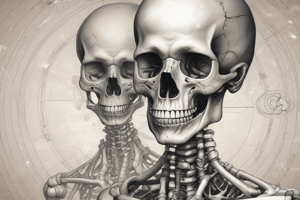Podcast
Questions and Answers
What is the primary characteristic of osteochondrodysplasias?
What is the primary characteristic of osteochondrodysplasias?
- Abnormalities in the formation of individual bones
- Abnormalities in cartilage and bone growth (correct)
- Neurological complications and respiratory difficulties
- Skeletal deformities and joint problems
What is a risk factor for developing skeletal dysplasias?
What is a risk factor for developing skeletal dysplasias?
- Maternal age over 35
- Environmental toxins
- Family history of diabetes
- Advanced paternal age (correct)
What is a common clinical feature of skeletal dysplasias?
What is a common clinical feature of skeletal dysplasias?
- Short stature or disproportionate short stature (correct)
- Obesity
- Tall stature
- Muscular weakness
What is a diagnostic tool used in the diagnosis of skeletal dysplasias?
What is a diagnostic tool used in the diagnosis of skeletal dysplasias?
What is a possible complication of skeletal dysplasias?
What is a possible complication of skeletal dysplasias?
What is a form of management and treatment for skeletal dysplasias?
What is a form of management and treatment for skeletal dysplasias?
Flashcards are hidden until you start studying
Study Notes
Definition Skeletal dysplasias are a group of genetic disorders that affect the development and growth of the skeleton.
Types
Osteochondrodysplasias
- Characterized by abnormalities in cartilage and bone growth
- Examples: Achondroplasia, Hypochondroplasia, Thanatophoric dysplasia
Dysostoses
- Characterized by abnormalities in the formation of individual bones
- Examples: Craniosynostosis, Ectrodactyly, Polydactyly
Causes and Risk Factors
- Genetic mutations (autosomal dominant, autosomal recessive, or X-linked)
- Advanced paternal age
- Family history of skeletal dysplasias
Clinical Features
- Short stature or disproportionate short stature
- Skeletal deformities (e.g., bowed legs, club foot)
- Joint problems (e.g., arthritis, limited mobility)
- Respiratory difficulties
- Neurological complications (e.g., hydrocephalus, spinal cord compression)
Diagnosis
- Clinical evaluation
- Radiographic examination (e.g., X-rays, CT scans)
- Molecular genetic testing (e.g., DNA analysis)
Management and Treatment
- Orthopedic interventions (e.g., surgery, bracing)
- Physical therapy and rehabilitation
- Pain management
- Genetic counseling
Complications
- Respiratory failure
- Neurological complications
- Increased risk of certain cancers (e.g., osteosarcoma)
- Reduced life expectancy
Studying That Suits You
Use AI to generate personalized quizzes and flashcards to suit your learning preferences.




